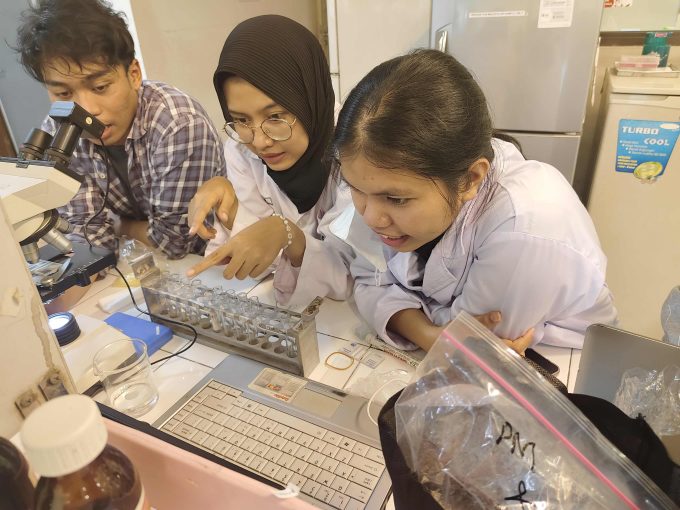
The world today is abuzz with the term “global boiling” due to the drastic increase in average temperatures in various parts of the world. Methane emissions are one of the causes of global boiling. The Global Monitoring Laboratory states that methane emissions have been rising since 1980, from 1,620 ppb to 1,933.46 ppb in October 2023. These emissions have the potential to increase global temperatures 28 times more than CO2. About 20-25% of total methane emissions come from livestock activities, specifically through enteric fermentation in the rumen of livestock, which produces methane gas that is then released through feces and burping.
This issue caught the attention of five students from Universitas Gadjah Mada, prompting them to research the use of seaweed (Gracilaria sp.) and noni fruit as feed additives to potentially modify rumen conditions and reduce methane production in livestock. The five students conducting this research are Ahmad Rizal Riswanda Danuartha (Animal Science and Industry Program, 2022), Aqidatul Izza (Aquatic Resource Management Program, 2022), Dinda Rahmasari (Animal Science and Industry Program, 2022), Elsia Manik (Chemistry Program, 2023), and Tanaya Bagus Priya Waskita (Animal Science and Industry Program, 2022). This research is part of the Student Creativity Program in Exact Research (PKM-RE), funded by the Ministry of Education and Culture Research and Technology, and supervised by a lecturer, Moh. Sofiul Anam, S.Pt., M.Sc.
Macroalgae, commonly known as seaweed, contain various secondary metabolites that can reduce methane emissions produced by cattle.
“We use the Gracilaria sp. macroalgae because it contains tannins, saponins, alkaloids, and flavonoids, which are believed to modify the fermentation process in the rumen by inhibiting the activity of methanogenic bacteria, thereby reducing methane production in the livestock sector without disrupting the digestion of the livestock itself,” said Ahmad Rizal, the head of the research team, on Tuesday (7/23).
Rizal added that besides using seaweed, this feed additive innovation also utilizes noni fruit, which is still minimally used in the livestock industry.
“In Yogyakarta, noni fruit production in 2021 reached 163,532 kg. However, this fruit is still rarely used, even though noni contains around 100 types of secondary metabolites, including tannins, polyphenols, flavonoids, and other compounds that we believe can modify the fermentation process in the rumen, similar to Gracilaria sp.,” he said.
The samples used in this research were sourced from various local resources available in Yogyakarta. “We sourced the seaweed samples from Sepanjang Beach, Gunungkidul. For the noni fruit, we obtained fresh noni from Berbah, Sleman. The seaweed was air-dried for 2 weeks, while the noni fruit was oven-dried at 55°C for 3 days. After that, the samples were extracted and dried using the freeze-drying method until the final form was granules,” explained Rizal.
Another team member, Elsia Manik, stated that the granules made from macroalgae and noni fruit would be tested for effectiveness through in vitro tests conducted at the Livestock Food Technology Laboratory, Faculty of Animal Science and the Organic Chemistry Laboratorium UGM. “During the in vitro test, we used rumen fluid from Bali cattle with a fistula, then we collected the gas to analyze the methane production. If the gas test results show a lower methane level than the standard, it means this feed additive innovation can reduce methane emissions from rumen fermentation,” explained Elsia Manik.
The addition of macroalgae and M. citrifolia extracts with doses of T2 (3% macroalgae + 3% M. citrifolia) and T3 (2% macroalgae + 4% M. citrifolia) showed an increase in dry matter digestibility by 5.78% and 4.73%, respectively. Additionally, methane production at 24 hours significantly decreased with doses of T1 (4% macroalgae + 2% M. citrifolia) and T3 (2% macroalgae + 4% M. citrifolia), by 14.04% and 33.1%, respectively. At 48 hours, methane production decreased by 27.78%. Initially, the energy in the feed was not optimally absorbed because it was used for methane production.
“We hope that with this innovation, methane emissions from the livestock sector can be reduced and gradually address climate change,” said Manik.
Source: PKM-RE Team
Editor: Satria
Translator: Prisilia Putri
